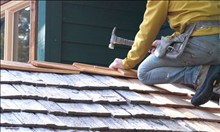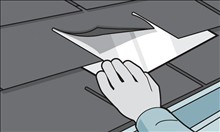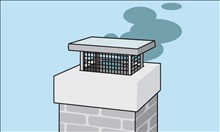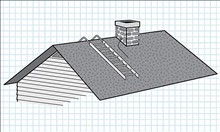5 roof-repair tips: How you can fix leaks and shattered shingles
Some roof problems are clearly for experts, but you should be able to fix minor leaks and broken shingles yourself. Here are some DIY roof tips, plus useful safety advice for when you get that ladder out.In the home – as in life – it’s often the little things that matter. And it’s amazing how many small structural things can go wrong around your house. Whether it’s the front-door lock that won’t let you into your own home or the cracked window that won’t keep the cold out, small household problems can have a big effect. For most of these, there’s no need to call for a repair professional – the solution lies in tapping your ingenuity and using a few common household materials in innovative ways. Even when it seems that the roof is falling in – or the floor is opening up beneath you – there are often simple ways to solve larger problems on your own.
1. Go with the pro: Assessing a roof leak.
 Some overhead leaks are due to minor problems – such as a single torn shingle or a small hole in flashing – that you can usually handle with a little DIY experience and some basic tools. But other situations call for a roofer’s expertise. Call a professional like Johnson Roofing as soon as possible; water damage spreads quickly, even from a small leak, if you can’t fix the problem quickly and completely. A licensed roofer is best when:
Some overhead leaks are due to minor problems – such as a single torn shingle or a small hole in flashing – that you can usually handle with a little DIY experience and some basic tools. But other situations call for a roofer’s expertise. Call a professional like Johnson Roofing as soon as possible; water damage spreads quickly, even from a small leak, if you can’t fix the problem quickly and completely. A licensed roofer is best when:
There are multiple leaks.
The leak is wicking across framing members or along walls, making it difficult for you to trace the source.
A repair you made is not holding.
The leak entails significant damage to roofing surface or flashed areas.
The roof surface, such as ceramic tile roof, is beyond your abilities.
 2. Shingles bar: A bad storm has damaged a shingle on your roof; you need to protect the roof from further damage by way of the compromised shingle.
2. Shingles bar: A bad storm has damaged a shingle on your roof; you need to protect the roof from further damage by way of the compromised shingle.
The quick fix
Gather a tube of roofing cement and a piece of aluminum flashing (available at home centers). Cut the flashing about 1 inch narrower than the ripped tab and about 4 inches longer so that it extends under the tabs on either side. Use a flat pry bar to carefully loosen the damaged tab and the tabs to the left and right. Next, apply two or three thick beads of roofing cement to the surface beneath the shingle.
Slip the flashing underneath and apply more roofing cement on top of the flashing. Press the tab down to adhere the flashing to the roof.
3. A shingle switch: A few of your wooden shingles have become split and you need to replace them.
The quick fix
A typical wood-shingle house is covered with thousands of individual shingles and, over time, it’s inevitable that a few will split or become damaged. To replace a single shingle, first use a chisel and hammer to split it into several narrow pieces, then yank them out with pliers. Slip a hacksaw blade under the shingle above and cut through the nails that held the old shingle in place. Next, use a utility knife to trim a new shingle to match the width of the space. Slide the shingle in place and tap it to within 1 inch of its final position. Drive in two galvanized cedar shingle nails at an upward angle, directly below the butt edge of the shingle above. Then use a wood hammer and block to tap the new shingle up into place. It’ll pull the nailheads up and behind the shingle above, as the shingle slides in place.
 4. Chimney seep: No matter what you do, the paint on your chimney masonry keeps peeling.
4. Chimney seep: No matter what you do, the paint on your chimney masonry keeps peeling.
The quick fix
Install a galvanized (good), stainless (better) or copper (best) rain cap. These start at about $30 and are available at most home-repair and building-supply outlets. “Peeling chimney paint is almost always caused by water working its way from the inside out,” explains John Stauffer, technical director at the Paint Quality Institute. “A rain cap will keep the bulk of the water out of the flue.”
 5. sound and Safe: Avoiding the freefall.
5. sound and Safe: Avoiding the freefall.
The quick fix
Working on a roof is obviously dangerous. But some simple safety measures can ensure that you don’t take the quick way down.
To minimize the possibility of a slip and to prevent damage to the roof, step on the roof as little as possible.
Buy or rent a roofer’s ladder with a bracket that bridges the ridge of the roof if you are going to do extensive work on the roof.
When on the roof, use a strong safety harness or belt secured by a lifeline attached to a stable fixture such as the base of a chimney.
Access the roof by way of a high-quality extension ladder secured to the house in at least two places.
Never work on a roof in icy conditions. Dark-colored shingles can hide ice patches.
